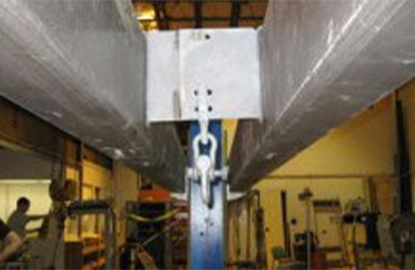Composite materials are made from two or more constituent materials with different physical or chemical properties which when combined form a material with characteristics different from the individual components. The individual components remain separate and distinct within the finished structure, resulting in a finished product that is stronger, lighter, or less expensive than traditional materials.
Composite polymers are therefore materials that are created when at least glass fibers and resin are combined together. Most of the time some other components such as fillers and additives are added to the mix to improve certain properties of the material during manufacturing and in final use.
Fiber-reinforced polymers (FRP) is a group of composite materials made of a polymer matrix that mechanically enhances their strength and other mechanical behaviors by using fiber materials. Their main applications include the automotive, construction, aerospace, and marine industries, the military, and lately electrical utilities.
The oldest composite is adobe where straw and clay and other ingredients are mixed together. One of the most elaborate ancient composite applications is bows made of bone, wood, sinew laminated together with some adhesive. Great empires were built using this technology that was considered the highest level in their time. The most advanced application of composites currently is in the spacecraft components.
The fibers used in composites today are typically glass, carbon, basalt, or aramid (one of them runs the trade name Kevlar). The polymer is generally an epoxy, vinyl ester, polyester, thermosetting plastic, phenol-formaldehyde resin, and the latest and the most advanced polyurethane.
FRP is created using two separate processes; the first process involves the manufacture and forming of the fibrous material, the second process involves bonding the fibrous material with the matrix.
FRP enables glass fibers of composites to be designed specifically to the needs of a certain application. Altering the orientation of the fibers can increase the strength of the element in the required direction. Reinforced polymers are strongest when the polymer fibers are parallel to the force direction and weakest when they are perpendicular to the force. Weak spots can be used as natural hinges. The orientation of the fibers is therefore are very important and they are usually oriented in two- and three-dimensional weaves to suit specific inner stress-strain structural demands.
FRP Transmission Innovation has produced a range of cross arms and cross beams constructed from fiber reinforced polymers using the most advanced polyurethane resin available, making it possible to create a material that is lighter and stronger than before. Compared to traditional materials like wood or steel, the cross arms and cross beams have a lower lifecycle cost, are less expensive, simpler and faster to install, and are maintenance-free.
To find out more about Transmission Innovation’s line of products check out our products page or call us at +1 778 285-8447.







